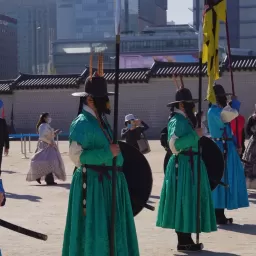Arts And Crafts
Korean arts and crafts continue to evolve, with contemporary artists blending tradition with modern sensibilities
 Bonus: Korean Culture:
Korean culture is a blend of tradition and modernity, preserving its heritage while embracing contemporary influences. Let’s learn more about it.
Bonus: Korean Culture:
Korean culture is a blend of tradition and modernity, preserving its heritage while embracing contemporary influences. Let’s learn more about it.
Traditional Korean arts and crafts have a rich history that spans centuries, and they have played a crucial role in shaping the cultural identity of Korea. Here are some key aspects of arts and crafts in Korea:
-
Ceramics and Pottery:
- Celadon Ware: One of the most well-known Korean ceramic traditions is the production of celadon ware, characterized by its distinctive green glaze. Goryeo celadon, produced during the Goryeo Dynasty (918–1392), is particularly celebrated for its exquisite craftsmanship and elegant designs.
- Buncheong Ware: Another notable style is buncheong ware, which emerged during the Joseon Dynasty (1392–1897). Buncheong ceramics are known for their unglazed surfaces decorated with white slip, creating a unique and rustic aesthetic.
-
Textile Arts:
- Hanbok: Traditional Korean clothing, known as hanbok, is a testament to the country’s textile arts. Hanbok features vibrant colors, intricate embroidery, and unique designs. The clothing reflects both historical and social aspects of Korean culture.
- Jogakbo: This is the art of patchwork, where small pieces of fabric are skillfully sewn together to create colorful and geometric designs. Jogakbo is often used to make wrapping cloths, known as bojagi, and other textile items.
-
Paper Arts:
- Hanji: Traditional Korean paper, known as hanji, is made from mulberry bark. Hanji is used for various artistic purposes, including calligraphy, painting, and crafting. The paper is known for its durability and versatility.
- Jiyounggi: This refers to traditional Korean bookbinding techniques. Jiyounggi involves the meticulous sewing of individual pages and covers, creating beautifully bound books.
-
Metalwork:
- Silla Metalwork: The Silla Kingdom (57 BCE–935 CE) is renowned for its metalwork, including intricate gold crowns and jewelry. Skilled metal artisans crafted items with intricate designs, reflecting the artistic sophistication of the time.
-
Woodcraft:
- Najeon Chilgi: This is the art of mother-of-pearl inlay on wooden surfaces. Elaborate designs are created using thin pieces of mother-of-pearl, creating a stunning visual effect. Najeon Chilgi is often applied to furniture, lacquerware, and decorative items.
-
Folk Painting:
- Minhwa: Traditional Korean folk painting, known as minhwa, features vibrant and stylized depictions of various subjects, including animals, landscapes, and symbolic motifs. Minhwa is often characterized by its bold colors and the use of traditional materials.
-
Contemporary Arts and Crafts:
- While preserving traditional techniques, contemporary Korean artists are exploring innovative ways to express themselves through arts and crafts. Modern artisans often fuse traditional methods with contemporary aesthetics, creating unique pieces that reflect Korea’s dynamic cultural landscape.
-
Cultural Significance:
- Korean arts and crafts are deeply tied to the country’s cultural and religious traditions. Many traditional crafts have roots in Confucianism, Buddhism, and shamanistic practices, contributing to the spiritual and cultural significance of the artworks.
Korean arts and crafts continue to evolve, with contemporary artists blending tradition with modern sensibilities. The preservation of these traditional crafts is valued as part of Korea’s cultural heritage, and efforts are made to pass down these skills to future generations.